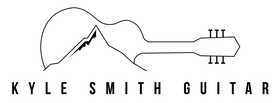 Learning how to use guitar scales is an important part of learning to play guitar. Scales provide a path towards improving your finger coordination while opening doors to learning more about music theory, learning songs by ear, and playing guitar solos. Musically speaking, there is no difference in scales played on the guitar, and scales played on any other instrument. Physically, the mechanics of the instrument dictate how the scale is played. With guitar scales, we are looking at finger patterns that can be used to play a specific scale at different points on the neck. Typically these finger patterns are what we call movable patterns - you can move them up or down the guitar neck and be able to play the same type of scale (and the same pattern) from different starting notes. What You Need To KnowAt first it can seem like there are way too many scales to ever learn. But the good news is that once you learn the basic patterns, you're all set. Many of the scales follow the same basic framework, just with some notes changing slightly. There are many different scales you could learn, but the important part is to pick one and get started. Which scale you start with isn't necessarily important as long as you actually learn to play it. For beginners I recommend the major pentatonic or minor pentatonic scale patterns. These are the ones that will give you the most "bang for your buck" as far as being able to use scales in your playing. For most styles of music, the pentatonic scales are your first and best choice for playing solos and creating riffs or guitar parts. You may as well start there if you're new to scales. There are a few different ways you can use your guitar scales, depending on what you want to get out of them. We'll look at some different options for using your scale patterns in this lesson. Learning RiffsThere are tons of riffs or guitar parts that are based off of scales If you're listening to a song that is using power chords, chances are those chords are following some kind of scale pattern. No one (even our guitar heroes) come up with this stuff by magic. The whole reason that scales exist is that they form musical sequences that we enjoy as humans - luckily someone wrote them down and gave them names. Next time you're trying to learn a riff, see if it fits (at least close to) a scale pattern you already know. Chances are it will fit a minor pentatonic or natural minor scale pretty closely (though there are definitely other options as well). Once you find the scale pattern that fits the riff, it's much easier to learn, play, and remember. Writing Your Own SongsMost of the music you hear day to day is based on a scale in some way, shape, or form. Chords, chord progressions, riffs, guitar solos, and melodies all can be traced back to a scale. If you're trying to write a song using riffs, try using a natural minor scale pattern as your template (Minor pentatonic or major scales also work well). Use your scale pattern to play around and find groups of notes that sound good to you. Keep it simple and short at first. Turn each of the notes in your pattern into a power chord (if you're playing in a rock style). If you're trying to write a song using chords, use the major scale pattern as your first resource. Most popular songs use chords based off of the 1st, 4th, 5th, and 6th notes of the major scale (there are always exceptions, but this is a good place to start). Play major chords for the 1, 4, and 5 chords - and play a minor chord for the 6 chord. When I say 1 chord, I mean that the root fo the chord matches up with the first note of the scale. 4 chord means that the root of the chord matches up with the 4th note of the scale, and so on. If you know your barre chords on the 6th and 5th strings already, you're good to go. Match the barre chords up with the notes of the scale and you've got your chords. Make sure the 6 chord is minor (a good rule of thumb most fo the time). If you don't know barre chords yet, no problem - you can use open chords. If you start your major scale pattern on the 6th string/3rd fret, you'll be in the key of G, so you only need to know chords in the key of G. The 1 is a G, 4 is a C, 5 is a D, and the 6 is Em. You can find these chord shapes easily right here. Playing Guitar SolosPlaying guitar solos was one of the biggest reasons I started working on playing scales in the first place. With a little practice, you can learn how to use guitar scales to play solos over any song you want. You can get a lot done with just the minor pentatonic or major pentatonic scale. Here are the steps to follow: Pick what song you want to play along with. You can also find a backing track on youtube. They're free and can be a lot of fun to play along with. Find out what Key the song is in. You can use trial by error - testing notes until one sounds really good, and trying the scale from there. This approach is probably the best one if you have the patience for it. You can look it up - songname + key is a good way to search for it. If you're using a backing track, you can decide what key you're looking for. Searching for backing track in Am will give you an A minor backing track. Start your scale from the note that matches the key. Play around with the scale, trying to find little melodies that you like. Using scales to make up your own guitar solos is the best way to get better at playing guitar solos. Building Technique And SpeedYou can use guitar scales to improve your technique - your ability to play the guitar. Learning different scale patterns will help you learn to control your fingers in different ways, and give you more possibilities of things you can play. If you want to take things even farther, there are technique drills you can practice using your scale patterns as well. By using a metronome or a drum track, you can gradually increase your speed over time. This will allow you to play faster songs, and have more control as you play slower songs. Speed isn't everything, but it's helpful if some of the songs you want to play are fast. I like to be able to feel relaxed at whatever speed I need to play for a given song. Understanding Music Theory And Playing By EarGuitar scales can be a gateway to understanding music theory, and to playing by ear. Many guitar teachers and players separate these two things as if you can do one but not the other. The truth is that these two aspects of playing - understanding theory and using your ears to guide you - are two sides of the same coin. You can't really play by ear if you don't understand music theory, and you can't really understand music theory if you aren't using your ears as well. Scales are a great tool for understanding music theory. Much of our music theory is based off of one sequence of notes - the major scale. The majority of music theory is presented in relation to this scale, and the intervals (note distances) within it. Practicing your major scale patterns and paying attention to the intervals can help you build a good, practical understanding of music theory. Playing by ear and understanding music theory go hand in hand. The tool for improving your ears and for understanding the basics of music theory is the same - intervals/scale tones. If you check out this lesson on major scales (or any of my scale lessons), you'll find two different diagrams for each scale. One is labeled with the suggested finger pattern, and the other is labeled with intervals/scale tones. These intervals/scale tones are where the magic happens. Play the scale while keeping track of the scale tones. That's it. You can say them out loud, sing along, say them in your head, or just follow them with your eyes as you play. By working this way, you are teaching your ears what each note of the pattern sounds like in context. You're learning what a 3 sounds like, or a 6, or any of the other scale tones in the pattern. This kind of practice will help you develop a good working knowledge of how scales work, and an instinct for what notes are going to sound like before you play them. Mastering The Guitar NeckLearning the guitar neck is a step that many guitar players struggle with. Being able to play your scales, chords, arpeggios, and licks at different points on the neck is an important skill. Knowledge of note names along the neck is important if you're going to move into an intermediate/advanced level of guitar playing. I don't agree with most of the advice out there for learning the neck. Most lessons about this focus on memorization, purely trying to recall what notes are at a given fret. This can work for some people, but even then you may have trouble applying that knowledge to your playing. You can use guitar scales as a way to learn the neck: Pick a key to play your scales in. Good ones to start with are A, E, G, or D. Find that note on each of the strings, and play the matching scale pattern. If you find the note on the 6th string, use the 6th string scale pattern. I like to go in string order for this exercise: 6th string, 5th string, 4th string, 3rd string, and 2nd string. You can also work the opposite way - 2nd string through 6th string. Note that there is no 1st string scale form - that's because the 1st and 6th strings are the same. Once you've found all 5 scales in that key, pick a new key and try again. This way you'll start to learn the notes on the neck along with improving your guitar scale skills. Think About ThisLearning how to use your guitar scales is a big part of playing guitar.
While people seem to agree that learning scales is important, not everyone has a good explanation for why they are important. In this lesson I've covered some of the things you can use your guitar scales for, so you can start to understand why practicing your scales is good for you. This is really just a big picture overview, so let me know if there is anything in here you want more help with. Ultimately how you use your guitar scales is up to you, and it depends on what your goals are right now. Keep playing, and let me know how it goes!
0 Comments
Your comment will be posted after it is approved.
Leave a Reply. |

